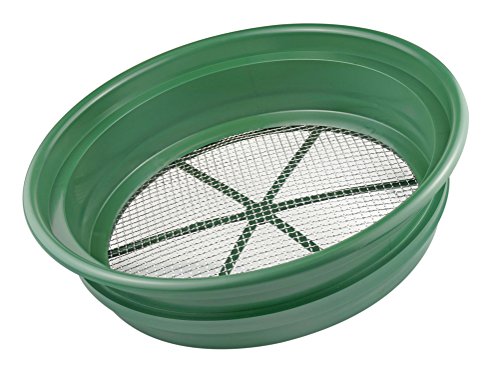Use this Patented Stackable 13-¼” Sifting Pan with ¼” Mesh Size at home, at work, or on your next adventure!
Why use our Sifting Pans (AKA classifiers/sieves)?
• Classification is the most important step in gold recovery.
• Screen off large, worthless gravel and rock.
• Size your material to the proper dimensions of the gold you are expecting to recover.
• Our high quality stainless steel wire mesh is both accurate and durable for everyday use.
• The plastic is both lightweight and durable.
Advantages of our stackable design:
• Resting the pans on top of each other takes up less space.
• The differently sized mesh screens make classifying even faster.
• Each pan fits perfectly on top of a 5-gallon bucket.
Patent Numbers:
United States: D666086
China: 201230049676.1
Canada: 146123
Important:
Avoid getting counterfeit items. Genuine SE products come with our SE logo on the packaging.
SE is committed to providing the customer with the best source for value possible. You will enjoy the quality, function and usefulness this Patented 13-¼” Stackable Sifting Pan, ¼” Mesh Size has to offer.
SE is a registered trademark protected by US Trademark Law.
Product Features
- Top diameter: 13-1/4″
- Mesh screen size: 1/4″
- Wire thickness: 0.95 mm
- Stackable design sits nicely on 5-gal. bucket
- U.S. Patent Number: D666086


Four Stars
Great for sifting top soil First, what I used them for and how they worked out:I purchased three of these. The 1/2, 1/4 and 1/8 sizes. I used them from largest to smallest to break up the clumps of dirt and sift out all of the rocks and other things that were in the top spoil I had. If you are looking to do the same and only want to buy one, I”d recommend this size (1/4). It is where the majority of the rocks I sifted were caught. The 1/2 didn’t catch anything, though it did break up the dirt in preparation for…
Worn out after just a week at Crater of Diamonds state park. I ordered a replacement set yesterday evening because in the set I’ve been using there are 2 of the 5 bodies with pieces broken out of the rims, and 3 of the 5 bodies where they stick together tightly when they’re nested – and all of that after only washing and classifying approximately 80 buckets (5 gal each) of soil and gravel at the Crater of Diamonds state park in Arkansas. None of the screens came loose on me even though I pushed quite a bit of material through them, but the bottom bracket…